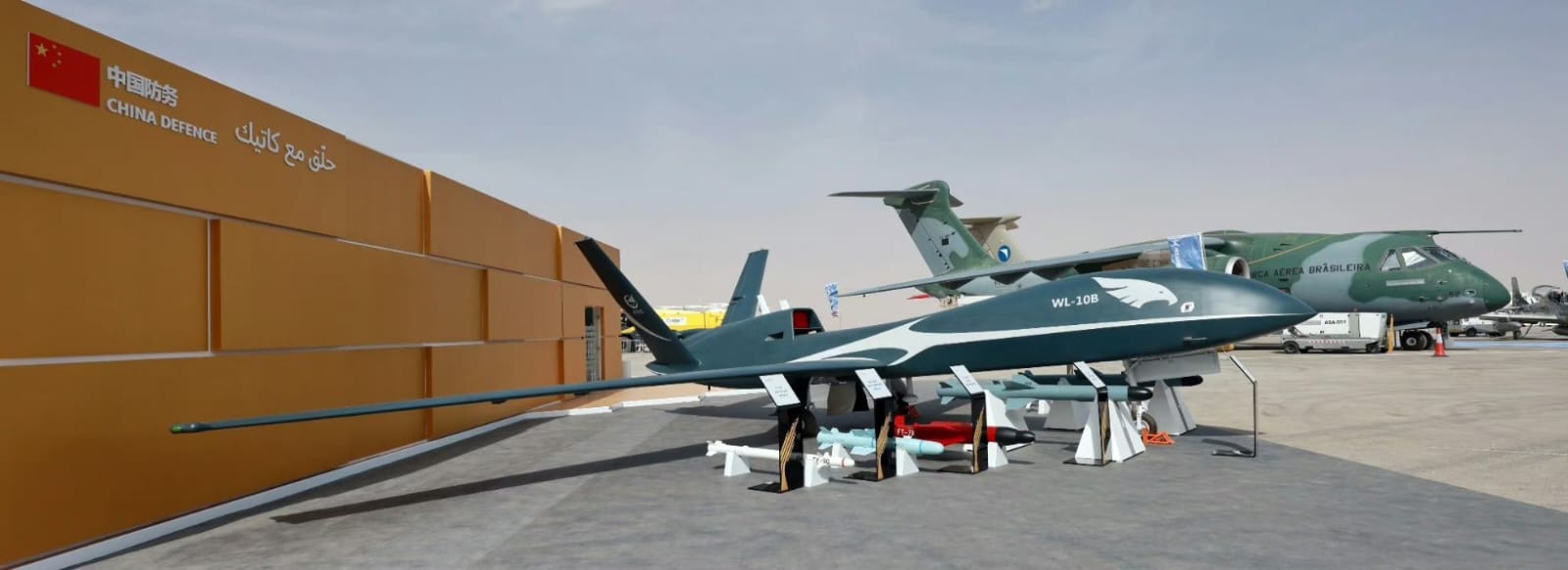The Royal Saudi Air Force (RSAF) will acquire the Wing Loong-10B (WL-10B) unmanned combat aerial vehicle (UCAV). The drone was displayed at the World Defense Show that concluded in the Kingdom of Saudi Arabia (KSA) on February 8.
Chinese drones were prominently displayed at the exhibition, where Beijing’s state-run and private defense technology firms exhibited diverse military wares.
KSA has been operating the Wing Loong-2 (WL-2) drone since 2017. The Chengdu Aircraft Industry Group displayed the WL-2 with the Saudi flag printed on its tail Wing (vertical stabilizer).
The WL-2 can carry 480 kg (1,058 pounds) of weapons for up to 32 hours. According to the South China Morning Post (SCMP), the drone was reportedly used in the Yemeni civil war against the Houthi militia.
WL-10B In West Asia
Drones have become increasingly crucial in regional conflicts, used by both non-state and state actors, including Hamas, Hezbollah, Houthis, Israel, and Iran. KSA’s acquisition of the WL-10B allows extensive aerial surveillance and reconnaissance missions over land and sea, especially when armed with guided air-to-ground missiles and bombs.
It is unknown if the RSAF has also selected these munitions for their WL-10B, but it is unlikely they wouldn’t want that strike capability either. While the KSA indeed has normalized ties with Iran through a China-brokered deal, its peace with the Houthis (also known as Ansarallah) remains tenuous at best.

The group also commands considerable autonomy from Iran and might independently decide to resume hostilities with Riyadh, which might seem unlikely given the high stakes Tehran, Riyadh, and Beijing have in avoiding another large war.
A rear-mounted turbojet engine powers the WL-10B and falls firmly in the high-altitude long-endurance (HALE)-class as a reconnaissance-strike Unmanned Combat Aerial Vehicle (UCAV). It sports a low-wing configuration, almost appearing to be a fused wing-body airframe. The ‘B’ designation is a classification of the export version of the WL-10.
The bulge on the dorsal front fuselage can hold a link for satellite navigation (SATNAV) and radio control antennae to connect with the ground control station. It has a tricycle landing gear and a V-shaped tail assembly aided by ruddervators that control surfaces on the aerial vehicle.
Janes noted that the engine intake is trapezoidal-shaped and has a concealed exhaust. The UCAV possesses a communication antenna and ultra/very-high-frequency (U/VHF) datalinks.
Surprisingly, it doesn’t show as a standard turreted and turntable electro-optic/infrared (EO/IR) system under the nose, as is a standard feature with UAVs. It might be installed on the configuration to be sold to the Saudi military during the manufacturing/assembly at the Aviation Industry of China (AVIC) factory.
The UAV can attain a top speed of 620 kilometers an hour and soar at 15,000 meters for roughly 20 hours. It can haul 900 kg of air-to-surface munitions, including gliding, rocket-powered missiles, and YJ-9E lightweight anti-ship missiles.
Other reports quote Chinese defense officials confirming that Beijing, too, operates the WS-10 in its military, which explains why KSA quickly chose to acquire it. A weapons platform already in service with the developer/seller country’s armed forces is a great selling point. It conveys to buyers that the weapon has practical military utility besides a steady supply of post-sale service and spare part availability.
Chinese Defense Firms Outshined Russia & US
But what was notable was China’s heavy presence at the defense exhibition that even outshined its Russian and American counterparts, marking its rise to a credible defense aerospace powerhouse status.
Breaking Defense said in coverage of the World Defense Show: “American defense firms may have come in droves to show off their wares, led by the likes of Lockheed Martin, Boeing, and Raytheon, but Chinese firms claimed the most floor space outside host nation Saudi Arabia.”
Beijing also put on an aerial demonstration for the first time, with J-10 fighters of the People’s Liberation Army Air Force’s (PLAAF) Ba Yi Aerobatic Team.
Data shared by organizers indicated that China’s floor space – much of it in a “China Defense” staging area – amounted to 4,668 square meters (over 50,000 square feet), the largest of any international invitee, ahead of Turkey with its outsized presence at 4,355 square meters and the US at 3,335. Russia tagged along with just over 800 square meters.
- The author can be reached at satamp@gmail.com
- Follow EurAsian Times on Google News